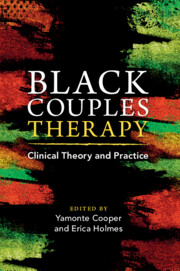Book contents
- Black Couples Therapy
- Black Couples Therapy
- Copyright page
- Contents
- Figures
- Tables
- Contributors
- Foreword
- Acknowledgments
- Introduction
- Part I Race, Racism, and Identity
- Part II Foundations for Healthy Coupling
- Chapter 4 The Foundations for Strong and Healthy Relationships between Black Men and Women: Purposes, Practices, and Processes
- Chapter 5 Considerations for Premarital Counseling and Education for Dating and Engaged Heterosexual African American Couples
- Part III Adapting Major Therapeutic Approaches for Work with African American Couples
- Part IV Sex and Intimacy
- Part V Special Topics
- Index
- References
Chapter 5 - Considerations for Premarital Counseling and Education for Dating and Engaged Heterosexual African American Couples
from Part II - Foundations for Healthy Coupling
Published online by Cambridge University Press: 27 July 2023
- Black Couples Therapy
- Black Couples Therapy
- Copyright page
- Contents
- Figures
- Tables
- Contributors
- Foreword
- Acknowledgments
- Introduction
- Part I Race, Racism, and Identity
- Part II Foundations for Healthy Coupling
- Chapter 4 The Foundations for Strong and Healthy Relationships between Black Men and Women: Purposes, Practices, and Processes
- Chapter 5 Considerations for Premarital Counseling and Education for Dating and Engaged Heterosexual African American Couples
- Part III Adapting Major Therapeutic Approaches for Work with African American Couples
- Part IV Sex and Intimacy
- Part V Special Topics
- Index
- References
Summary
Research continually finds that those who marry live longer, on average, and tend to be healthier than those who never marry, divorce, or become widowed. Marriage has been demonstrated to positively impact wealth attainment, mental health, and social status. While there has been a decline in marriage for the general U.S. population, African Americans have the lowest marriage rates and the highest divorce rate of any other ethnic group. Despite these findings, survey data indicate that African Americans continue to place a high value on marriage as well as desire marriage. A legacy of anti-Black racism, discrimination, and oppression has profoundly shaped the African American family structure and has impacted marriage rates and marriage success. There is a dearth of research and curriculum specifically developed to address the unique factors related to marital satisfaction in African American couples. However, it stands to reason that addressing these factors can contribute to relationship fulfillment and stability among married African American couples. The authors attest to the need for a premarital counseling curriculum for African American heterosexual couples that specifically addresses the unique history of African Americans and the challenges experienced in their marriages.
Keywords
- Type
- Chapter
- Information
- Black Couples TherapyClinical Theory and Practice, pp. 102 - 124Publisher: Cambridge University PressPrint publication year: 2023



